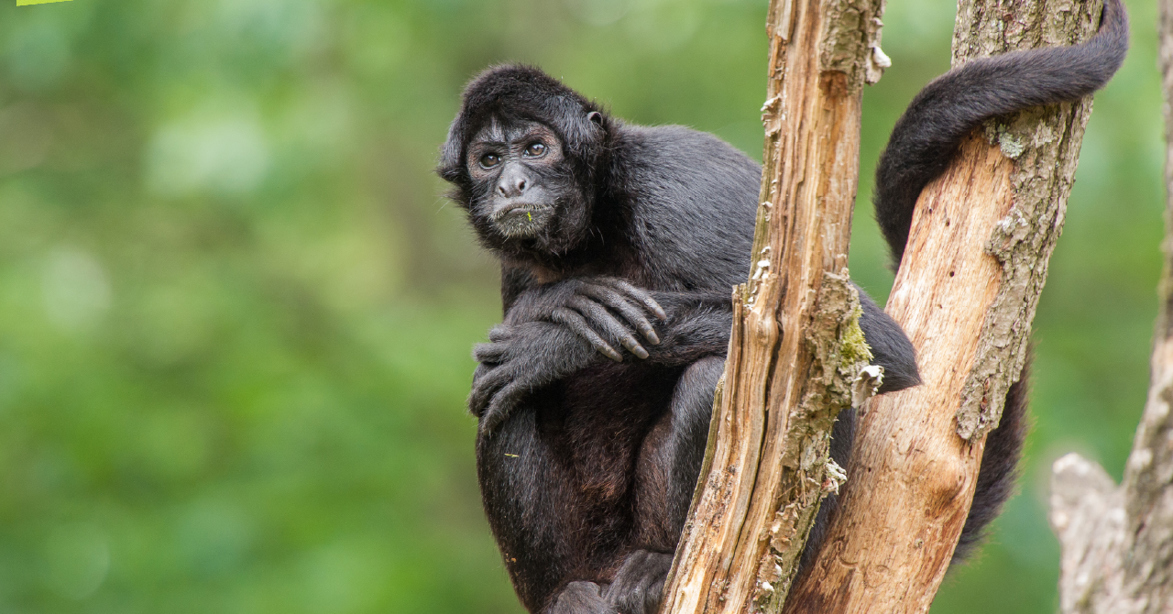Brown-Headed Spider Monkey
Ateles fusciceps rufiventris
Habitat
Tropical rainforest, cloud forests
Food
Fruit, leaves and seeds
Weight
♂ ± 9 kg | ♀ ± 8 kg
Age
± 25 years
IUCN Status
Kwetsbaar
Appearance
Brown-headed spider monkeys have black fur. Their faces are pink-ish and they have white hairs on their chin. The males are slightly larger than the females. They have a thin body with long, slim arms and legs. Males have an olfactory gland on their chest with which they can deposit scents. Brown-headed spider monkeys’ tails are really prehensile. Their tails are actually like a fifth hand which they use to hold themselves up and to grasp things. Their tails can even support their entire body weight. A striking detail on female brown-headed spider monkeys is the pink ‘appendage’ on their behind. This is their clitoris.
Habitat
Brown-headed spider monkeys live in the tropical rainforests of western Colombia and eastern Panama (in South America). They live in the highest regions of the trees and rarely come down to the ground.
Lifestyle
They live in fission-fusion social groups. The composition of the groups changes constantly and consists of 3-35 animals. Usually the females are in charge. Both males and females live in a clearly defined hierarchy. The males guard the territory.
Behaviour
Brown-headed spider monkeys embrace and cuddle frequently. They do this almost three times as often while they are grooming each other! They greet each other with an embrace. They do this every time a large group splits into smaller groups to go foraging. These foraging expeditions are always coordinated by one female. Brown-headed spider monkeys have excellent memories and are very good at remembering routes they have taken through the trees. That is handy for knowing where to find food. Brown-headed spider monkeys communicate with each other using all sorts of sounds.

Reproduction
Most brown-headed spider monkeys in the wild are born during the (brief) rainy season. The newborns have wrinkly faces and a fairly bald body. By the time they are three months old they are completely covered in black fur. Mothers carry their young offspring around on their bellies for about four months. Then the young animal moves onto its mother’s back. Males generally remain in their natal group. Females leave their natal group when they are ready to reproduce (when they are five or six years old).
Situation in the wild
Brown-headed spider monkeys are in danger of extinction. Logging is destroying the forests where they live and people also hunt brown-headed spider monkeys for their meat and to trade as pets. Both these threats have a huge impact on their population in the wild.

At Apenheul
The oldest spider monkey in Apenheul, Pepi, moved to the park in 1971. In 2018 we celebrated spider monkey Pepi’s fiftieth birthday. Of all the primates at Apenheul’s she has been living here the longest! So she is definitely a very special resident.
Population management programme
Apenheul is part of the European endangered species programme (EEP) for brown-headed spider monkeys. By working together with other zoos we ensure a genetically healthy and demographically stable population of this species is maintained in zoos.
Fun facts
Spider monkeys eat lots of fruit. They excrete the seeds, enabling new plants and fruit to grow. In this way they help to distribute seeds and produce their own food, as it were!
There are numerous types of spider monkeys. When they hang from the trees they look a bit like a spider in its web. That is where the name ‘spider monkey’ comes from.
Want to see the Brown-Headed Spider Monkey at Apenheul?
Get your tickets now and spot all the primate species!

Welcome to Apenheul
Open for business events
Park open from Friday 20 March, 10.00 hour